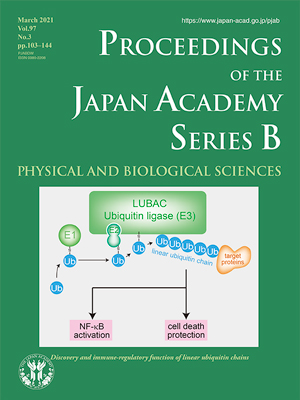About the Cover
Vol. 97 No. 3 (2021)
The ubiquitin conjugation system was identified as part of the energy-dependent protein degradation pathway. In this pathway, ubiquitin chains function as recognition tags for the 26S proteasome, and ubiquitinated proteins are destined for degradation. Ubiquitin research has thus flourished in close association with proteolysis, and in 2004 the Nobel Prize in Chemistry was awarded to ubiquitin researchers for the discovery of ubiquitin-mediated protein degradation. However, ubiquitin research has expanded beyond proteolysis, and the ubiquitin system is now known as a sophisticated reversible post-translational modification system that modulates protein functions in many ways by decorating proteins with ubiquitin chains. The type of ubiquitin chain determines the mode of protein regulation. It has been shown that several types of ubiquitin chains are found in cells, and ubiquitin chains are formed via one of seven Lys residues within ubiquitin. Ubiquitin chains are conjugated to substrates recognized by ubiquitin ligases (E3s) through the repetitive function of three enzymes consisting of E1, E2, and E3. Because E3s recognize substrates, the spatial relationship between enzymes (E3s) and the reaction sites (inter-ubiquitin linkages) changes during the chain elongation step. In the course of tackling a mysterious contradiction to the principles of enzymology, Dr. Iwai and colleagues (this issue, pp. 120-133) identified a new type of linear ubiquitin chain linked through the N-terminal Met of ubiquitin and assembled by linear ubiquitin chain assembly complex (LUBAC), which is specific for linear chains. The discovery of linear ubiquitin chains and LUBAC is considered a paradigm shift in ubiquitin research, because linear ubiquitination is exclusive to animals, despite the existence of ubiquitination throughout eukaryotic kingdoms. After the discovery of linear ubiquitination and LUBAC, Dr. Iwai’s research group showed that linear ubiquitination plays crucial roles in immune signaling by augmenting NF-κB activation elicited by various stimuli and suppressing programmed cell death including apoptosis and necroptosis. They also showed that dysregulation of LUBAC-mediated linear ubiquitination underlies various human diseases, including autoinflammation, autoimmunity, infection, and malignant tumors. Thus, LUBAC is a suitable target for the treatment of infections, immunological diseases, and cancer. The studies by Dr. Iwai and colleagues provide unique strategies to inhibit as well as promote LUBAC-mediated linear ubiquitination, and it is expected that the discovery and elucidation of LUBAC-mediated linear ubiquitination will further contribute to human welfare.
On the front cover, a model is shown of how the linear ubiquitin chain generated by LUBAC is responsible for NF-κB signaling and cell death regulation.
Keiji Tanaka
Board Chairperson
Tokyo Metropolitan Institute of Medical Science




